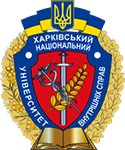Peculiarities of natural honey classification in the course of forensic commodity examination
Abstract
The main identification tasks of the commodity expertise of natural honey are to establish its authenticity, quality and assessment of compliance with the requirements of standards. To achieve these objectives, experts conduct a number of analyses and determinations, including determining the authenticity of honey, determining the botanical and geographical origin of honey, determining the composition and quality, determining compliance with quality standards, and determining the content of impurities and antioxidants. By carrying out these identification tasks, the examination helps ensure quality and safety of honey on the market and protects consumer rights. Defects in honey can occur for a variety of reasons and are usually the result of deficiencies in honey production, storage or transportation.
The scientific article describes the peculiarities of classification of natural honey during forensic commodity examination, reveals the methodological aspects of forensic commodity examination of honey, identifies theoretical and practical problems of commodity research of honey, reveals the commodity characteristics of honey and its defects, instrumental methods of honey examination, in particular gas and liquid chromatography, spectroscopy, solid-phase microextraction, describes the main microbiological methods that can be used in the study of honey, offers a systematisation of information data on the peculiarities of forensic examination of honey with regard to its characteristic defects. The stages of conducting a forensic commodity examination of honey are presented. Recommendations regarding honey quality assessment for expert organizations and consumers are given.
Downloads
References
De-Melo, A., Almeida-Muradian, L., Sancho, M., & Pascual Maté, A. (2017). Composition and properties of Apis mellifera honey: A review. Journal of Apicultural Research, 57(1), 5–37. http://doi.org/10.1080/00218839.2017.1338444.
Kutsak, R. S., & Kaplan, O. V. (2015). Veterinary and sanitary expertise of honey different geographical origin. Science and Technology Bulletin of Scientific Research Center for Biosafety and Environmental Control of Agro-Industrial Complex of Dnipropetrovsk State Agrarian and Economic University, 3(4), 84–87.
Becerril-Sánchez, A. L., Quintero-Salazar, B., Dublán-García, O., & Escalona-Buendía, H. B. (2021). Phenolic compounds in honey and their relationship with antioxidant activity, botanical origin, and color. Antioxidants, 10(11). https://doi.org/10.3390/antiox10111700.
Machado, A. M., Miguel, M. G., Vilas-Boas, M., & Figueiredo, A. C. (2020). Honey Volatiles as a Fingerprint for Botanical Origin – A Review on Their Occurrence on Monofloral Honeys. Molecules, 25(2). https://doi.org/10.3390/molecules25020374.
Lazarević, K. B., Jovetić, M. S., & Tešić, Ž. L. (2017). Physicochemical Parameters as a Tool for the Assessment of Origin of Honey. Journal of AOAC International, 100(4), 840–851. https://doi.org/10.5740/jaoacint.17-0143.
Samchuk, H. P. (2016). Status and trends of national and international honey markets. Young Scientist, 12(40), 958–961.
Dankevych, V. Ye., Dankevych, Ye. M., & Pyvovar, P. V. (2018). Forming conjuncture in the world honey market: current state and prospects for Ukrainian exporters. Agricultural and Resource Economics, 4(2), 37–54.
Kai, W., Sha, Ya., & Xiaofeng, X. (2023). Natural Toxins in Honey. In G. W. Smithers (Ed.), Encyclopedia of Food Safety (2nd ed.) (pp. 544–563). Academic Press.
Bodor, Z., Benedek, C., Behling, H., & Kovacs, Z. (2023). Fusion of electronic tongue and NIRS for the detection of heat treatment of honey. LWT, 186, 115–219. https://doi.org/10.1016/j.lwt.2023.115219.
Dubinina, A. A., Ovchynnikova, I. F., Dubinina, S. O. et al. (2010). Methods of determining falsification of goods. Professional.
Lazarieva, L. M., Kovtun, V. A., & Shtanhret, L. I. (2015). Quality analysis of the honey from western region of Ukraine. Veterinary Medicine, 101, 57–59.
Kahanets, O. (2010). Evaluation of honey according to international and national criteria. Food Industry of Agriculture, 1, 26–29.
Vidican, C., & Rotarescu, R. (2010). Impact assessment of thermal processimg and storage conditions on enzymatic activity and HMF content in honey. Carpathian Journal of Food Science and Technology, 2(1), 3–13.
Turynskyi, V. M., & Adamchuk, L. O. (2015). Important issues development of beekeeping. Scientific Bulletin of the National University of Bioresources and Nature Management of Ukraine. Series: Technology of Production and Processing of Animal Husbandry Products, 223, 190–195.
Kędzierska-Matysek, M., Florek, M., & Wolanciuk, A. (2016). Characterisation of viscosity, colour, 5-hydroxymethylfurfural content and diastase activity in raw rape honey (Brassica napus) at different temperatures. Journal of Food Science and Technology, 53(4), 2092–2098. https://doi.org/10.1007/s13197-016-2194-z.
Malynka, О., Antipina, О., & Derechina, А. (2023). Examination of samples of flower honey and study of the conditions of its stabilization. Scientific Works, 86(2), 13–21. https://doi.org/10.15673/swonaft.v2i86.2480.
Copyright (c) 2023 P. P. Kanivets

This work is licensed under a Creative Commons Attribution 4.0 International License.



